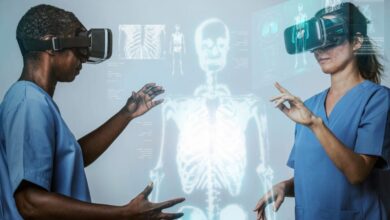Robotic Surgery Precision, Safety, And Ethical Concerns

Delving into Robotic Surgery: Precision, Safety, and Ethical Concerns, this discussion invites you to explore a transformative approach in modern medicine. Robotic surgery combines advanced technology with surgical expertise, offering unprecedented precision and safety for patients undergoing various procedures. As we navigate this innovative field, we’ll uncover how these systems work, the types of surgeries they support, and the ethical considerations that accompany their use.
With the rise of robotic surgery, we witness a significant shift in how surgical operations are conducted. The integration of robotics enhances accuracy and minimizes invasiveness, which is crucial in complex surgeries. Additionally, the implications for patient recovery periods and overall outcomes are noteworthy. Join us as we delve deeper into the nuances of this evolving medical landscape.
Introduction to Robotic Surgery
Robotic surgery represents a significant evolution in the field of modern medicine, utilizing advanced technology to enhance precision and safety during surgical procedures. This innovative approach allows surgeons to perform complex operations with increased dexterity and control, often resulting in minimal invasiveness and quicker recovery times for patients. The integration of robotics into surgical practices has transformed traditional methods, making surgeries less traumatic and more efficient.
Technological advancements have played a pivotal role in the rise of robotic surgery. Key developments in imaging technology, computer software, and robotic engineering have culminated in sophisticated surgical systems that are capable of performing intricate tasks with remarkable accuracy. These innovations enable surgeons to visualize the surgical site in high-definition 3D, manipulate instruments with robotic arms that mimic human motion, and execute precise movements that may be challenging with conventional techniques.
Types of Robotic Surgery Systems
A variety of robotic surgical systems are currently in use, each tailored to meet specific surgical needs. Understanding these systems is essential for appreciating their capabilities and applications in various medical fields. Some of the prominent systems include:
- da Vinci Surgical System: Widely recognized in the field, this system has been employed in urological, gynecological, and general surgeries. It features a console where surgeons control robotic arms equipped with surgical instruments, offering a high level of precision.
- MAKO Surgical System: Primarily used for orthopedic procedures, the MAKO system enhances joint replacement surgeries by providing a 3D visualization of the joint and allowing for improved precision in implant placement.
- Versius Surgical System: This modular robotic system is designed for various surgical applications, including general surgery and thoracic procedures. Its versatility and flexibility allow for easy adaptation in operating rooms.
- Senhance Surgical System: Focused on laparoscopic surgery, the Senhance system incorporates haptic feedback, giving surgeons a tactile sensation similar to traditional surgery while still utilizing robotic assistance.
These robotic systems have become vital tools in enhancing surgical outcomes. By facilitating minimally invasive procedures with a high degree of accuracy, they contribute to reduced pain, shorter hospital stays, and faster recoveries, fundamentally changing the landscape of surgical care.
Precision in Robotic Surgery
The advent of robotic surgery has heralded a new era of precision in the medical field. These advanced systems offer a level of accuracy that traditional surgical methods simply cannot match. By utilizing state-of-the-art technology, robotic surgery enhances the surgeon’s capabilities, leading to improved patient outcomes and reduced complications.
Robotic systems significantly enhance precision through advanced visualization, dexterous movement, and enhanced control. Unlike traditional techniques, robotic surgery provides surgeons with a 3D high-definition view of the surgical site, allowing for a more thorough examination and precise maneuvering. This level of detail is particularly crucial in delicate procedures such as cardiac surgery, where even the slightest error can have dire consequences. For instance, in prostatectomies, robotic systems can target prostate tissue with utmost accuracy, preserving surrounding nerves and minimizing damage. This results in lower rates of postoperative complications, such as incontinence and erectile dysfunction, enhancing patients’ quality of life.
Minimally Invasive Techniques, Robotic Surgery: Precision, Safety, and Ethical Concerns
Robotic systems play a pivotal role in advancing minimally invasive surgical techniques. By allowing surgeons to perform complex procedures through smaller incisions, robotic surgery minimizes trauma to the body. The benefits of this approach are substantial, impacting both the surgical experience and recovery process for patients. The following points illustrate the advantages of robotic surgery in minimally invasive techniques:
- Reduced Blood Loss: Smaller incisions lead to less disruption of blood vessels, resulting in lower blood loss during surgery.
- Less Pain: Minimally invasive procedures typically cause less pain post-surgery, reducing the need for pain medication and enhancing patient comfort.
- Shorter Hospital Stays: Patients often experience faster recovery times, which can lead to shorter hospital stays and quicker return to daily activities.
- Lower Infection Rates: With less exposure of internal organs and tissues, the risk of infection decreases significantly.
- Improved Cosmetic Outcomes: Smaller incisions lead to less noticeable scarring, improving the overall aesthetic result for the patient.
The precision afforded by robotic systems not only transforms the surgical landscape but also enhances patient care by promoting faster recoveries and better long-term outcomes. The integration of these systems into modern surgical practices continues to demonstrate their potential to redefine standards in surgical precision and safety.
Safety Considerations
In the realm of robotic surgery, ensuring patient safety is paramount. The integration of advanced robotic systems into surgical procedures has transformed the landscape of healthcare, offering enhanced precision and minimally invasive options. However, it is crucial to establish robust safety protocols to mitigate risks associated with these complex technologies.
Essential safety protocols in robotic surgery encompass a variety of measures designed to protect patients. These include rigorous pre-operative assessments, sterile techniques to prevent infections, and real-time monitoring of surgical processes. Before initiating any robotic procedure, surgeons must undergo comprehensive training to familiarize themselves with the robotic systems and the specific procedures they will be performing. Additionally, the surgical team must engage in thorough pre-operative briefings to ensure everyone is aware of their roles and responsibilities.
Complications and Success Rates in Robotic Surgeries
The success rates and complication statistics associated with robotic surgeries are significant when evaluating their safety. Research demonstrates that robotic-assisted surgeries generally yield positive outcomes, with success rates often exceeding those of traditional surgical methods. For example, data from the American Urological Association indicates that robotic prostatectomy has a success rate of approximately 90%, with lower rates of complications such as bleeding and infection compared to open surgery.
When discussing complications, it is essential to consider both minor and major adverse events. A review published in the Journal of Robotic Surgery found that the overall complication rate for robotic procedures ranges from 3% to 15%, depending on the type of surgery and the experience of the surgical team.
“Robotic surgeries have the potential to reduce recovery times and hospital stays, enhancing overall patient satisfaction.”
Training and Certification Requirements for Surgeons
The training and certification required for surgeons operating robotic systems are critical to the success and safety of robotic surgeries. Surgeons typically need to complete specialized training programs provided by the manufacturers of the robotic systems. These programs cover essential skills, including system setup, operation, and troubleshooting during procedures.
Furthermore, many institutions require surgeons to achieve certification from recognized bodies, ensuring they meet specific competency levels. Ongoing education and simulation training are also vital, allowing surgeons to refine their skills and stay updated on advancements in robotic technologies.
Incorporating these training protocols not only enhances the individual surgeon’s skill set but also promotes a culture of safety within surgical teams. The synergy between well-trained personnel and advanced robotic systems is crucial to minimizing risks and improving patient outcomes in robotic surgery.
Ethical Concerns in Robotic Surgery
The integration of robotic surgery into modern healthcare has sparked significant ethical discussions that are vital for ensuring patient safety and quality of care. As we navigate this landscape, it is essential to explore the ethical implications of robotic surgery, including the potential over-reliance on technology and the cost disparities that may affect access to these advanced surgical procedures.
One of the most pressing ethical considerations in robotic surgery revolves around patient care and informed consent. Patients must be adequately informed about the benefits and limitations of robotic surgery compared to traditional methods. Understanding the complexities of these procedures is crucial for patients to make informed decisions about their treatment options. Healthcare providers should ensure that patients are aware of potential complications that may arise from robotic techniques, particularly when they may differ from those associated with conventional surgery.
Over-reliance on Technology in Surgical Practice
The increasing dependency on robotic systems poses a risk to traditional surgical skills. While robotic platforms can enhance precision and reduce recovery times, there is a concern that reliance on such technology may diminish a surgeon’s hands-on abilities. It becomes critical to maintain a balance between utilizing advanced technology and preserving the foundational skills that surgeons have developed over years of training.
The potential risks of over-reliance on robotic assistance include:
- Reduced manual dexterity: Surgeons may become less proficient in performing surgeries without robotic assistance.
- Skill degradation: As robotic systems handle more procedures, the opportunity for surgeons to practice traditional techniques may decline.
- Technical failures: A malfunction or error in robotic systems can lead to severe complications, emphasizing the need for surgeons to maintain their core skills.
Cost Implications and Accessibility for Different Patient Demographics
The financial aspect of robotic surgery raises ethical questions regarding equity in healthcare access. While robotic systems can potentially reduce the length of hospital stays and improve recovery times, the initial costs associated with these technologies can be substantial. This creates disparities in access to care, especially for underprivileged populations or those without adequate insurance coverage.
Factors influencing the cost implications and accessibility include:
- High initial investment: Healthcare facilities often face significant costs when acquiring robotic surgical systems, which can lead to higher surgery fees for patients.
- Insurance coverage limitations: Many insurance providers may not cover robotic surgeries, or may only do so under specific circumstances, leaving some patients with out-of-pocket expenses.
- Geographical disparities: Access to robotic surgery can vary widely between urban and rural areas, where advanced technologies may not be readily available.
Addressing these ethical concerns is essential for fostering a responsible approach to the adoption of robotic surgery in clinical settings. By ensuring equitable access and maintaining surgical expertise alongside technological advancements, the healthcare community can better serve the diverse needs of patients while upholding ethical standards in patient care.
Future Trends in Robotic Surgery
As we look to the future of robotic surgery, it’s clear that ongoing research and advancements in technology are shaping a new era in medical practice. The integration of robotics into surgical procedures is not only enhancing precision and safety but also revolutionizing the way surgeries are performed. This section delves into the latest developments, envisioning tomorrow’s operating room and exploring the role of artificial intelligence and machine learning in robotic surgery.
Ongoing Research and Developments in Robotic Surgical Technologies
The landscape of robotic surgery is rapidly evolving, with numerous research initiatives aimed at improving surgical outcomes and capabilities. Innovations are focusing on miniaturization, enhancing dexterity, and improving the ergonomics of robotic systems. Current research includes:
– Development of next-generation robotic platforms that allow for greater degrees of freedom and more intuitive control by surgeons.
– Advancements in haptic feedback technology, which enables surgeons to “feel” tissues, improving tactile sensation during procedures.
– Exploration of flexible robotic systems that can navigate complex anatomical structures, reducing the need for large incisions.
Moreover, there is a push towards creating fully autonomous robotic systems that can perform specific surgical tasks with minimal human intervention, potentially transforming surgical workflows.
Vision of the Future Operating Room
The operating room of the future will be a highly integrated environment, combining advanced robotics with state-of-the-art imaging technologies. This futuristic setting will likely feature:
– Robotic surgical units that are seamlessly connected to imaging systems, providing real-time data and enhanced visualization during operations.
– Augmented reality (AR) interfaces that assist surgeons by overlaying critical information directly onto their field of view, improving decision-making and procedural accuracy.
– Collaboration hubs enabling multiple surgeons to work together remotely, using robotic systems to perform surgeries in different locations.
In this envisioned operating room, the combination of robotics and advanced imaging will create a more efficient and patient-centric surgical experience.
Integration of Artificial Intelligence and Machine Learning in Robotic Surgery
The integration of artificial intelligence (AI) and machine learning (ML) into robotic surgery is paving the way for smarter surgical systems. These technologies are being utilized to analyze vast amounts of surgical data, enabling predictive analytics that can enhance decision-making processes. Key aspects include:
– Training algorithms that learn from past surgeries, allowing robotic systems to improve their performance over time based on outcomes.
– Real-time data analysis which assists in identifying potential complications during procedures, thereby increasing patient safety and reducing risk.
– Enhanced surgical planning tools that utilize AI to create personalized surgical approaches based on individual patient anatomy and conditions.
As AI and ML continue to develop, their integration into robotic surgery will not only streamline workflows but also significantly enhance the precision and safety of surgical interventions.
Case Studies and Real-World Applications
Robotic surgery has transformed the landscape of medical procedures, offering enhanced precision and better outcomes for patients. As we delve into various case studies, it becomes clear that the integration of robotic systems in the operating room has significantly impacted surgical success rates and patient experiences. The following explorations illustrate not only the types of surgeries performed but also the technologies that power them and the testimonies from patients who have benefited.
Successful Robotic Procedures
Numerous case studies highlight the effectiveness of robotic surgery across various medical fields. Below is a table summarizing different surgeries, the robotic systems used, and the outcomes observed in each case. This evidence illustrates the versatility and reliability of robotic assistance in surgery.
| Surgery | Robotic System | Outcome |
|---|---|---|
| Prostatectomy | da Vinci Surgical System | Minimal blood loss, shorter recovery time, improved continence rates |
| Hysterectomy | Versius Surgical System | Reduced postoperative pain, quicker return to normal activities |
| Cardiac Valve Repair | CorPath GRX System | Higher accuracy in suturing, reduced hospital stay |
| Spinal Surgery | ROSA Spine | Increased precision, fewer complications, faster recovery |
The outcomes of these surgeries indicate a trend toward less invasive procedures, which has become a hallmark of robotic surgery. With reduced blood loss and minimized scarring, patients often experience shorter recovery times and less postoperative discomfort.
Patient Testimonials
Patient experiences provide invaluable insight into the impact of robotic surgery on quality of life. Here are a few testimonials that showcase the transformation and relief patients have felt following their procedures:
“After my robotic prostatectomy, I was amazed at how quickly I was back on my feet. The pain was minimal, and my doctor said I had a much quicker recovery than traditional methods.” – John D.
“The precision of the robotic surgery for my hysterectomy meant I had less downtime. I was back to my routine within a week, which I never expected.” – Sarah L.
“I was nervous about my heart surgery, but the robotic-assisted approach made all the difference. I felt reassured knowing the precision that came with the technology.” – Michael K.
These testimonials underscore the profound effect robotic surgery has on not just physical health, but also on overall patient satisfaction and confidence in their medical choices. As robotic systems continue to evolve, the potential for even greater advancements in surgical care remains promising.
Global Perspectives on Robotic Surgery: Robotic Surgery: Precision, Safety, And Ethical Concerns
The adoption of robotic surgery varies significantly across different countries and healthcare systems, influenced by factors such as technological advancement, economic conditions, and cultural perceptions of medical practices. As robotic surgery continues to gain traction globally, understanding these regional differences is crucial for better integration and utilization of this technology.
Many countries have embraced robotic surgery, with varying levels of success and challenges. The United States leads in the adoption of robotic surgical systems, with a reported 15% annual growth rate in robotic-assisted surgeries. In contrast, European countries like Germany and the UK have also seen significant uptake, but the rate is tempered by regulatory hurdles and varying reimbursement policies. In Asia, countries like Japan and South Korea are rapidly increasing their adoption rates, driven by a strong emphasis on technological innovation in healthcare.
Adoption Rates and Statistics
Robotic surgery has seen varying adoption rates across the globe, influenced by multiple factors including healthcare infrastructure, financial resources, and physician training programs. The following points highlight key statistics regarding global adoption rates:
- In the United States, more than 1.5 million robotic surgeries are performed annually, making it the largest market for robotic systems.
- According to a report from the International Federation of Robotics, Europe accounted for approximately 30% of the global robotic surgical market in 2022.
- In Asia, countries like Japan and China are rapidly expanding their robotic surgery capabilities, with Japan reporting a 25% increase in robotic procedures from 2020 to 2022.
- Emerging markets in Latin America and Africa face slower adoption rates, primarily due to limited access to funding and advanced technology.
Barriers to Implementation
Despite the benefits of robotic surgery, several barriers hinder its implementation in various regions. These barriers range from financial constraints to cultural resistance towards new technologies. Identifying these challenges is essential for developing strategies to overcome them. Key barriers include:
High initial costs of robotic systems and maintenance can deter healthcare facilities from adopting this technology.
- Lack of trained personnel to operate robotic systems effectively poses a significant challenge, particularly in developing countries.
- Regulatory and reimbursement issues in certain countries may limit the financial viability of offering robotic surgical options.
- Cultural attitudes towards surgical interventions can influence the acceptance and demand for robotic procedures in different regions.
Overcoming Implementation Barriers
Various regions are adopting innovative strategies to tackle the barriers associated with robotic surgery. Collaborative efforts, government support, and enhanced training programs are proving effective:
- Countries like India are leveraging public-private partnerships to fund the acquisition of robotic systems, making them more accessible to public hospitals.
- In Europe, healthcare providers are advocating for clearer reimbursement pathways that would incentivize hospitals to invest in robotic technologies.
- Training initiatives are being developed globally to enhance the skills of surgeons and medical staff, ensuring that the benefits of robotic surgery can be fully realized.
- Awareness campaigns are conducted to educate patients and healthcare providers about the advantages of robotic surgery, addressing cultural misconceptions.
Final Conclusion
In conclusion, Robotic Surgery: Precision, Safety, and Ethical Concerns reveals a fascinating intersection of technology and healthcare. As robotic systems continue to advance, they shape the future of surgical practices and patient care. The ethical implications and safety measures surrounding these technologies must be carefully considered to ensure that patient welfare remains the priority. This ongoing dialogue will be essential as we embrace the potential of robotic surgery in transforming medical outcomes.
User Queries
What are the main benefits of robotic surgery?
Robotic surgery offers enhanced precision, reduced recovery times, and minimal invasiveness, leading to less pain and scarring for patients.
How are surgeons trained to use robotic systems?
Surgeons undergo specialized training programs that include simulations, hands-on practice, and certification processes to ensure proficiency in robotic techniques.
What types of surgeries are commonly performed robotically?
Common robotic surgeries include prostatectomies, hysterectomies, and cardiac valve repairs, among others, where precision is critical.
Are there any risks associated with robotic surgery?
While robotic surgery is generally safe, potential risks include complications similar to traditional surgery, such as infection or bleeding, as well as equipment malfunction.
How does the cost of robotic surgery compare to traditional methods?
Robotic surgery is often more expensive than traditional surgery due to the cost of equipment and training, but it may lead to lower overall healthcare costs through reduced complications and shorter recovery times.






